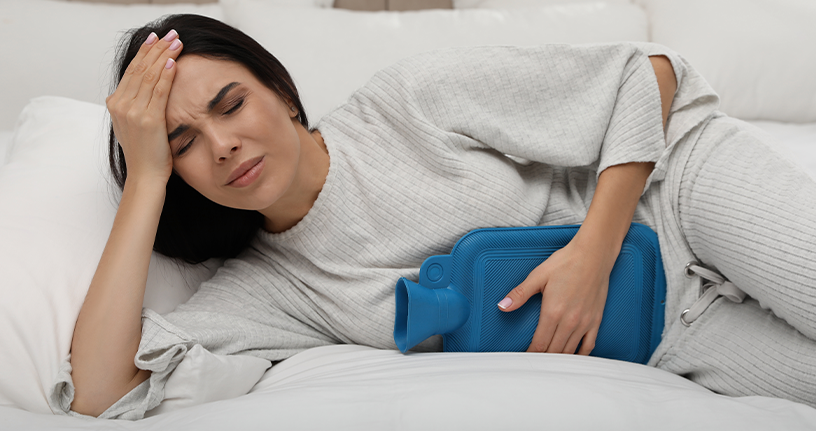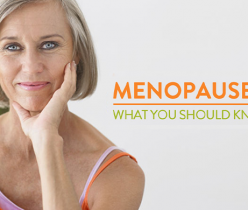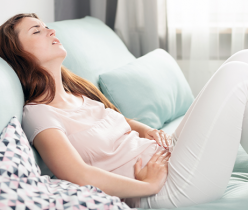Menstrual pain (period pain), also called dysmenorrhea, is commonly considered synonymous in clinical practice. They indicate a cramping, dull, throbbing pain that usually initiates from the lower abdomen and occurs before and during menstruation. Health care experts say menstrual pain lighter than dysmenorrhea, called normal menstrual cramps, could exist. Dysmenorrhea seems to be associated with prolonged and heavier-than-normal menstrual flow, low body mass index, low body weight, inadequate physical exercise, cigarette smoking, stress, diet, mental illness, and genetic predisposition.
Key facts about the menstrual period
Dysmenorrhea or painful periods is a common problem. Painful periods are one of the leading causes of women missing work and school. If you have dysmenorrhea, you are not alone. If data is to be believed, around 80% of women experience period cramps at some stage in their lifetime. Many women feel discomfort during the menstrual cycle, especially on the first or second day. But in 5 to 10% of women, the pain is severe enough to interfere with their daily activities. If your mother suffered severe menstrual cramps, you are more likely to experience them too. In some women, menstrual pain is accompanied by premenstrual symptoms, such as tender breasts, bloating, swollen stomach, mood swings, tiredness, clumsiness, and lack of concentration. There are two types of dysmenorrhea:
-
-
- Primary – This dysmenorrhea occurs in people who experience pain before and during menstruation.
- Secondary – If you have normal periods that become painful in later years of life, it is known as secondary dysmenorrhea. Secondary dysmenorrhea may be caused due to a condition that affects the uterus or other pelvic regions, such as endometriosis or uterine fibroids.
-
What are the causes of painful periods?
It is not always possible to determine the cause of painful periods. Some people are just at higher risk of having painful periods. These risks are:
-
-
- Having a family history of a painful menstrual cycle
- Being under the age of 20
- Having irregular periods
- Having heavy bleeding with periods
- Never have a baby
- Reaching puberty before age 11
-
A prostaglandin hormone causes muscle contractions in your uterus that expel the lining. These muscle contractions can give rise to pain and inflammation. The level of prostaglandin hormone increases right before menstruation begins. Painful periods can also occur due to an underlying medical condition. These conditions are:
-
-
- Premenstrual syndrome (PMS) – Premenstrual syndrome, also known as PMS, is a common disorder in women that is caused due to hormonal changes in the body that occurs 1 to 2 weeks before menstruation begins. Symptoms usually disappear after bleeding begins.
- Endometriosis – This is a painful condition in which cells from the lining of the uterus develop in other body parts, usually on the ovaries, fallopian tubes, or tissue that lines the pelvis.
- Pelvic inflammatory disorder (PID) – PID is an infectious condition that affects the uterus, ovaries, or fallopian tube; that often occurs due to sexually transmitted bacteria that brings inflammation of the reproductive organs and pain.
- Fibroids in the uterus – Fibroids are non-cancerous. They appear as tumours that can pressure the uterus and disturb your menstrual cycle, resulting in increased pain, though they often do not cause symptoms.
- Cervical stenosis – A rare disorder in which the cervix becomes too small or narrow that it slows the menstrual flow, resulting in increased pressure inside the uterus that causes pain.
- Adenomyosis – This rarely happens in this condition where the uterine lining grows into the muscular wall of the uterus, resulting in pressure, pain, and inflammation. It can also give rise to longer or heavier periods.
-
Also Read – Menorrhagia: Menstrual Disorder In Women
Home treatments
In most cases, at-home treatments can help with period pain relief and make you rid of muscle cramps experienced during the menstrual cycle. Certain home-based muscle cramps treatments, you can try at home are:
-
-
- Taking a warm bath
- Massing your abdomen
- Using a heating pad for cramps in your pelvic region or back
- Practising relaxation techniques or yoga
- Doing regular physical exercise
- Eating nutritious meals
- Taking anti-inflammatory medicines such as ibuprofen before your due date
- Taking vitamins and supplements such as vitamin E, vitamin B1, vitamin B6, omega three fatty acids, magnesium, or calcium
- Reducing your intake of alcohol, salt intake, caffeine, and sugar to prevent bloating
- Raising your legs or lying with your knees bent
-
When to consult a doctor
If menstrual pain is severe enough to interfere with our ability to perform even your daily basic tasks each month, it may be the right time to consult an expert specialized in treating women’s health issues. Your doctor may prescribe medicine for period pain that will depend on the severity and underlying cause of your pain. If sexually transmitted diseases or PID are causing pain, your doctor will prescribe antibiotic drugs to eliminate the infection. Consult your doctor about the best medicine for severe menstrual cramps.
Conclusion
More than half of women who have menstrual periods have some pain for around a day or two each month. Usually, the pain is mild, but sometimes, it is severe enough to keep them away from activities. When the pain is severe, it is termed dysmenorrhea. At home, treatments can help you relieve dysmenorrhea. Menstrual pain relief drugs also exist for severe cases. Consult a doctor if your condition is serious. Your doctor will recommend the best medicines for severe menstrual pain.
Also, Read – What You Need to Know About Vaginal Pain




